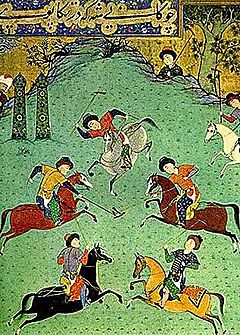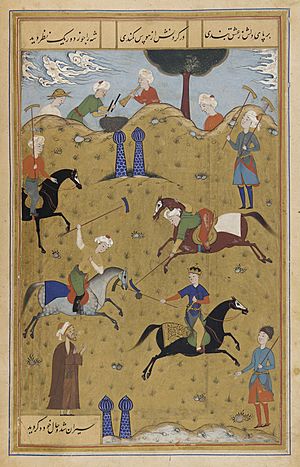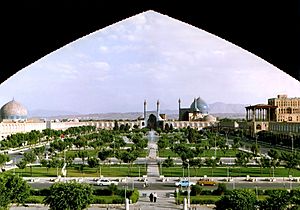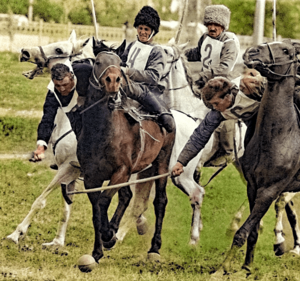Chovgan facts for kids

|
|
| Players | 6 |
|---|---|
| Playing time | 30 minutes |
| Chovqan, a traditional Karabakh horse-riding game in the Republic of Azerbaijan | |
|---|---|
|
UNESCO Intangible Cultural Heritage
|
|
| Country | loan |
| Reference | 00905 |
| Region | Europe and North America |
| Inscription history | |
| Inscription | 2013 (8th session) |
| Chogān, a horse-riding game accompanied by music and storytelling | |
|---|---|
|
UNESCO Intangible Cultural Heritage
|
|
| Country | Iran |
| Reference | 01282 |
| Region | Asia |
| Inscription history | |
| Inscription | 2017 (12th session) |
Chovgan, also called Chowgan or Chogan, is an exciting team sport played on horseback. It started in ancient Iran (which was once called Persia). This game was seen as a sport for important people like kings and nobles. It was played on special fields with horses trained just for the game.
Chovgan became popular across many Asian countries. Today, you can still find it played in Iran, Azerbaijan, Tajikistan, and Uzbekistan. Later, this sport traveled to the Western World. There, it became known by a different name: polo.
History of Chovgan
Chovgan began in ancient Persia and was a national sport. It was very popular among the noble families. Both women and men played Chovgan. The game started around the middle of the first millennium A.D.. It stayed popular for many centuries in the Middle East.
Ancient pictures and writings often showed parts of the game. Some old books even gave detailed rules. Chogān is an Iranian horse-riding game that includes music and storytelling. It has been played in Iran for over 2,000 years. It was mostly played in royal courts and city fields.
Some historians believe it started as early as the 5th century BC. The first records of polo come from the Medes, an ancient Iranian people. During the Parthian Empire (247 BC - 224 AD), kings and nobles loved and supported the sport.
According to The Oxford Dictionary of Late Antiquity, polo was called čowgān in Middle Persian. It was a Persian ball game and a favorite activity in the Sasanian Empire (224–651). Learning Chovgan was also part of royal education. Emperor Shapur II learned to play polo when he was just seven years old in 316 AD.
Englishmen helped spread and develop the game in Europe and worldwide. Chovgan was brought from India to England in the 19th century. It became more popular there. New rules helped the game spread in Europe and the United States. Englishmen gave the game its current name, "polo." It was even part of the Olympic Games in 1900 in Paris.
Chovgan in Iran
In the Sasanian Empire, Chovgan was called čowkān. It was an important part of royal education. The nearby Eastern Romans learned Chovgan from the Sasanians. They called it tzykanion. This name came from the Middle Persian word.
During the rule of Theodosius II, the Roman court began playing tzykanion. They played in a special stadium called a tzykanisterion. By the time of the Tang dynasty (618–907), polo was well-known in China. Its popularity in China was likely helped by the presence of the Sasanian court there.
Polo was first used as a training game for cavalry units. These were usually the king's guard or other special soldiers. Over time, polo became a national sport in Iran. It was played mainly by the nobility. Both women and men played the game. For example, a queen and her ladies played against King Khosrow II Parviz in the 6th century AD.
Persian writings and art give us the best stories about polo from ancient times. Ferdowsi, a famous Iranian poet, wrote about royal chogan tournaments. He did this in his 9th-century epic, Shahnameh (the Book of Kings). He praised the skills of a legendary prince named Siyâvash on the polo field. Ferdowsi also wrote about Emperor Shapur II of the Sasanian dynasty. He learned to play polo when he was only seven years old.
Naqsh-i Jahan Square in Isfahan is an old polo field. King Abbas I built it in the 17th century.
Sultan Qutb al-Din Aibak was a Turkic military leader. He later became Sultan of Delhi Sultanate. Sadly, he passed away in 1210 while playing polo.
From Persia, polo spread to the Byzantines. They called it tzykanion. After the Muslim conquests, it spread to the Ayyubid and Mameluke dynasties in Egypt and the Levant. Their leaders loved it more than any other sport. Famous sultans like Saladin and Baybars were known to play it. They also encouraged it in their courts.

Later, polo went from Persia to other parts of Asia. This included the Indian subcontinent and China. It was very popular during the Tang dynasty. Many paintings and statues show the game. It was great for training cavalry. The game was played from Constantinople to Japan during the Middle Ages. In the East, it is known as the "Game of Kings." The name polo is thought to come from the Tibetan word "pulu," which means ball.
In 2017, Chogān from Iran was added to the UNESCO Cultural Heritage List.
Chovgan in Azerbaijan

In Azerbaijan, chovqan (Azerbaijani: Çövkən) is seen as a national sport. Old pictures and pottery show that the sport has a long history there. For example, a pot with pictures of a chovgan game was found near Beylagan city. This suggests the game existed around the 11th century.
Mentions of the chovgan game also appear in famous writings. These include “Khosrow and Shirin” by the poet Nizami Ganjavi. It is also in the Turkic epic “Kitabi Dede Korkut”.
One type of this game was very popular in Azerbaijan. Two teams try to score a goal using special clubs. Here are the rules for the modern game:
- Two goals, 3 meters wide, are set up.
- Each goal has a semi-circle area with a 6-meter radius.
- The game is played with a rubber or woven leather ball.
- The clubs can be different shapes. In Azerbaijani, the clubs look like a shepherd's crook.
- Each team has six riders. Four are attackers, and two are defenders.
- Defenders can only play in their own half of the field.
- Goals can be scored from outside the penalty area.
- The game lasts 30 minutes, split into two periods.
In 1979, a documentary called “Chovgan game” was made. It showed the rules and history of the sport. However, during the Soviet era, the sport almost disappeared. It was also hard to breed horses after the Soviet Union ended. But in recent years, the sport has started to come back.
Since 2006, Azerbaijan has held a national tournament. It is called the President's Cup. It takes place every December near Shaki. The first tournament was held from December 22–25, 2006. Teams from eight cities played, and Aghstafa won.
In 2013, chovqan was added to the UNESCO list of Intangible Cultural Heritage. This means it needs urgent protection to keep it alive.
See also
- Polo
- Chowgan ground
- Chowgan, Kermanshah
- International Chovgan Federation (IGF) for Chovgan established in 2 February 2024



